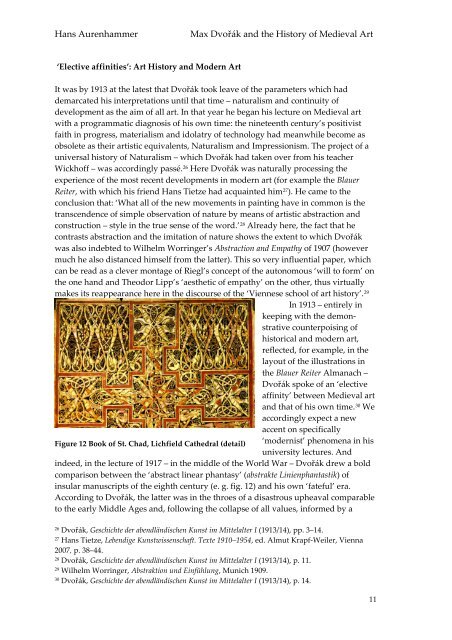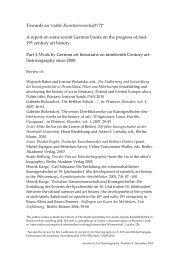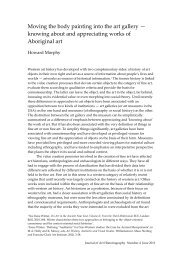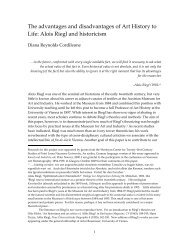Max Dvorák und die Revision der Mittelalter-Kunstgeschichte im ...
Max Dvorák und die Revision der Mittelalter-Kunstgeschichte im ...
Max Dvorák und die Revision der Mittelalter-Kunstgeschichte im ...
Create successful ePaper yourself
Turn your PDF publications into a flip-book with our unique Google optimized e-Paper software.
Hans Aurenhammer <strong>Max</strong> Dvořák and the History of Me<strong>die</strong>val Art<br />
‘Elective affinities’: Art History and Mo<strong>der</strong>n Art<br />
It was by 1913 at the latest that Dvořák took leave of the parameters which had<br />
demarcated his interpretations until that t<strong>im</strong>e – naturalism and continuity of<br />
development as the a<strong>im</strong> of all art. In that year he began his lecture on Me<strong>die</strong>val art<br />
with a programmatic diagnosis of his own t<strong>im</strong>e: the nineteenth century’s positivist<br />
faith in progress, materialism and idolatry of technology had meanwhile become as<br />
obsolete as their artistic equivalents, Naturalism and Impressionism. The project of a<br />
universal history of Naturalism – which Dvořák had taken over from his teacher<br />
Wickhoff – was accordingly passé. 26 Here Dvořák was naturally processing the<br />
experience of the most recent developments in mo<strong>der</strong>n art (for example the Blauer<br />
Reiter, with which his friend Hans Tietze had acquainted h<strong>im</strong>27 ). He came to the<br />
conclusion that: ‘What all of the new movements in painting have in common is the<br />
transcendence of s<strong>im</strong>ple observation of nature by means of artistic abstraction and<br />
construction – style in the true sense of the word.’ 28 Already here, the fact that he<br />
contrasts abstraction and the <strong>im</strong>itation of nature shows the extent to which Dvořák<br />
was also indebted to Wilhelm Worringer’s Abstraction and Empathy of 1907 (however<br />
much he also distanced h<strong>im</strong>self from the latter). This so very influential paper, which<br />
can be read as a clever montage of Riegl’s concept of the autonomous ‘will to form’ on<br />
the one hand and Theodor Lipp’s ‘aesthetic of empathy’ on the other, thus virtually<br />
makes its reappearance here in the discourse of the ‘Viennese school of art history’. 29<br />
In 1913 – entirely in<br />
keeping with the demonstrative<br />
counterpoising of<br />
historical and mo<strong>der</strong>n art,<br />
reflected, for example, in the<br />
layout of the illustrations in<br />
the Blauer Reiter Almanach –<br />
Dvořák spoke of an ‘elective<br />
affinity’ between Me<strong>die</strong>val art<br />
and that of his own t<strong>im</strong>e. 30 We<br />
accordingly expect a new<br />
accent on specifically<br />
Figure 12 Book of St. Chad, Lichfield Cathedral (detail)<br />
‘mo<strong>der</strong>nist’ phenomena in his<br />
university lectures. And<br />
indeed, in the lecture of 1917 – in the middle of the World War – Dvořák drew a bold<br />
comparison between the ‘abstract linear phantasy’ (abstrakte Linienphantastik) of<br />
insular manuscripts of the eighth century (e. g. fig. 12) and his own ‘fateful’ era.<br />
According to Dvořák, the latter was in the throes of a disastrous upheaval comparable<br />
to the early Middle Ages and, following the collapse of all values, informed by a<br />
26 Dvořák, Geschichte <strong>der</strong> abendländischen Kunst <strong>im</strong> <strong>Mittelalter</strong> I (1913/14), pp. 3–14.<br />
27 Hans Tietze, Lebendige Kunstwissenschaft. Texte 1910–1954, ed. Almut Krapf-Weiler, Vienna<br />
2007, p. 38–44.<br />
28 Dvořák, Geschichte <strong>der</strong> abendländischen Kunst <strong>im</strong> <strong>Mittelalter</strong> I (1913/14), p. 11.<br />
29 Wilhelm Worringer, Abstraktion <strong>und</strong> Einfühlung, Munich 1909.<br />
30 Dvořák, Geschichte <strong>der</strong> abendländischen Kunst <strong>im</strong> <strong>Mittelalter</strong> I (1913/14), p. 14.<br />
11

















